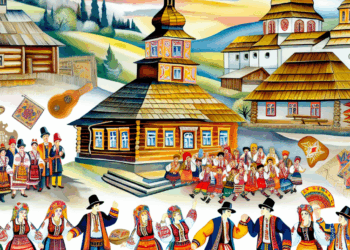Introduction
Bukovina is a region with a rich history, located at the crossroads of Eastern European cultures and civilisations. The history of this region has many historical events, traditions and personalities that had a significant impact on its development. In this article, we will look at little-known but significant facts covering various historical periods – from princely times to the Soviet era.
Princely time: fusion of cultures
Acceptance of Christianity and influence of Moravian missionaries
Bukovina was part of Kievan Rus’, and in the 10th-11th centuries there was an active adoption of Christianity. One of the key events was the influence of Moravian missionaries such as Saints Cyril and Methodius. Their activities promoted the spread of Christianity among the local population. It is worth noting that the Cyrillic alphabet, developed for the Slavic peoples, had a profound influence on the writing and culture of the Bukovinian Slavs.
The role of the Moldovan princes
Bukovina became part of the Principality of Moldavia in the 14th century, becoming the centre of political and cultural events. The king of Moldova was Alexandru in the East, known as Alexandru the Great, who ruled the principality from 1418-1432. His reign was marked by the consolidation of power and cultural flourishing, thanks to which the Bukovinians gained access to new knowledge and traditions.
The need for a strong feudal system was also important. This order served as a means for local rulers to maintain control over land and population.
Architectural monuments
Some little-known architectural monuments of the time, such as the Church of St Nicholas in Suceava, built in the 14th century, remain significant cultural heritage sites. This building is characterised by a unique style that combines Gothic and Byzantine elements.
Times of the Austrian Empire: cultural diversity and educational development
Conquest and integration (1775)
In 1775, Prussia and the Austrian Empire signed an agreement that ceded Bukovina to Austria. This event opened new horizons for education and culture, as evidenced by the establishment of educational institutions.
Establishment of a university in Chernivtsi
In 1875, the University of Chernovtsy was founded, which became one of the leading educational institutions in Central Europe. Among its teachers were such famous personalities as the philosopher and sociologist Mikhail Petrovich. The university became a symbol of cultural and scientific progress, facilitating the exchange of ideas between different ethnic groups.
It is noteworthy that the educational process was conducted in several languages: German, Ukrainian, Romanian and Polish. This emphasised the multinationality of the region and contributed to the rapprochement of different ethnic communities.
Influence of national minorities
Bukovina was home to many ethnic groups, including Ukrainians, Romanians, the Jewish population, and Germans. These groups influenced the culture and life of the region. For example, the Jewish community living in Chernivtsi contributed significantly to the economic development of the city, becoming a centre for trade and crafts. A similar Jewish community women’s organisation, Haverot, assisted the poor and supported cultural initiatives.
Interwar years: national movements and economic instability
Political situation
After the First World War and the collapse of the Austro-Hungarian Empire, Bukovina became part of the Romanian Kingdom. At this time, various national movements became active and Bukovinians began to seek self-identification. Interestingly, in the 1920s, the Ukrainian People’s Republican Party was founded in Chernivtsi, which favoured the rights of the Ukrainian population. Although short-lived, it played an important role in the formation of national consciousness.
Economy and culture
The economic situation remained unstable, which contributed to the migration of the population. Bukovina became a place for the resettlement of Polish and Jewish families from other regions. This led to increased cultural exchange and diversity in the region.
This was also the time when Ukrainian literature began to flourish. Poets and writers such as Osip Mandelstam and Vasyl Stefanik created works reflecting local traditions and culture. their work often touched on the theme of identity and belonging.
The Soviet era: changes and limitations
Accession to the Soviet Union (1940)
In 1940, against the backdrop of the Second World War, Bukovina was incorporated into the Soviet Union. This event brought significant changes in the social, political and cultural life of the region. Interestingly, many local organisations were transformed into state and collective farms, which contributed to a change in the traditional way of life.
Repressions and their consequences
In the 1930s and 1940s, many Bukovinians became victims of political repressions. Many writers, artists and intellectuals were arrested and sent to camps or forced to emigrate. Nevertheless, this time was also an epoch of the creation of new art forms, such as mass culture and social realism.
Education and science
The Soviet education system significantly changed the infrastructure of educational institutions. Many vocational and technical schools were established in Bukovina. Interestingly, it was at this time that an evening school for workers was opened in Chernivtsi, which contributed to the increase of literacy among the population.
Conclusion
The history of Bukovina is a history of cultures, ideas and traditions, in which each epochal turn created a unique context for shaping the identity of the local population. It is only by looking at little-known aspects of this history that we can realise how rich and diverse was the path of Bukovina from princely times to the Soviet era.








